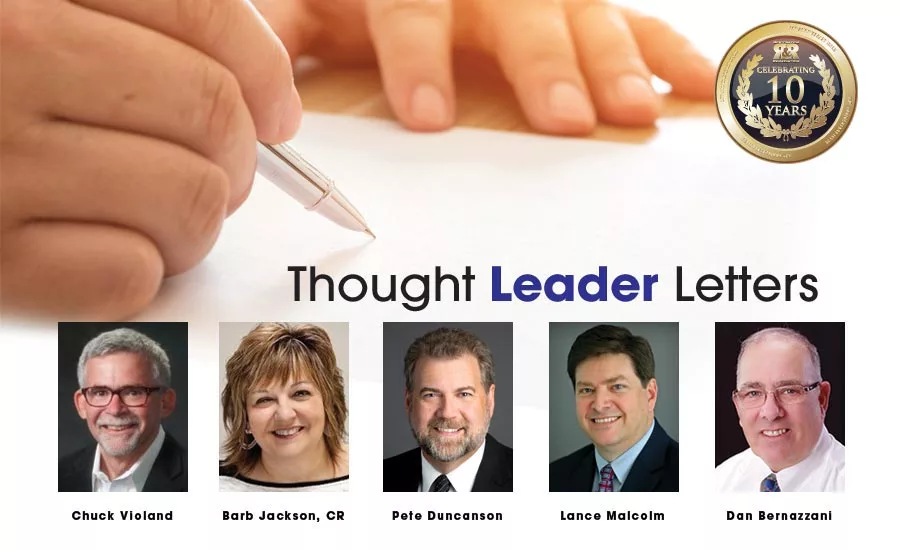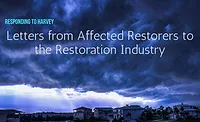Special Section: R&R 10th Anniversary Issue
Restoration Thought Leader Letters

Competition & Numbers
Having spent forty years in the restoration industry, most of them from a privileged seat where I’ve been able to observe industry changes on a national and even international level, it’s easy to see how the restoration landscape has changed over the years.
It would be difficult to isolate one area of change that has affected the industry more than any other, because there have been so many. The changes in drying and building sciences; changes in technology from how jobs are scoped, estimated, and executed in the field to how data is collected and used to better manage projects in the office; changes in electronic and social media. On a larger scale, there have been changes within the insurance industry with how losses are adjusted and paid; the growing number of Third Party Administrators; the increased number of large national and regional restorers and the influence they wield; the influx of private equity money into the industry; and the increasingly litigious nature of our work and the U.S. society in general.
In my opinion, many of these changes were in response to a much larger shift that has taken place over the last several years having to do with competition and numbers. The numbers have started being noticed by people who care about numbers, and this has led to changes in the competitive landscape. While many of these changes have been in the works for decades, they have picked up speed in the last ten years.
Gone forever are the days when restorers could thumbnail estimates or hip-shoot pricing, provide little or no documentation on jobs, hire unskilled, low-wage workers, or expect that having fancier tchotchkes to hand out to agents and adjusters would actually grow their businesses. And that’s okay, because much of this is just the natural maturing of an industry.
The contractors who are thriving today and will continue to thrive in the future are the ones who embrace these industry changes rather than objecting to or complaining about them. Those who roll their sleeves up and commit to running their businesses like a business, which is what the market is demanding and what is driving these changes.
There will always be changes, so we must find ways to create greater value for our customers in ways our competitors either won’t or can’t duplicate, regardless of our competitor’s size. It means finding ways to relentlessly drive costs down in order to drive profits up—profits that can then be used to invest in better technology and in hiring better talent who can continue the cycle of greater efficiencies and greater profits. Naturally, this involves a lot of hard work to better understand our numbers, understand our people, and understand our own capacities as business leaders when it comes to risk and change.
While competition will continue to evolve and large restorers will continue to grow, there will always be a home in the restoration industry for the single-location restorer; the restorer who wants to do a great job on a local level and has no interest in expanding nationally or regionally. The number of these companies will change and the way they compete will have to change if they’re going to provide any level of financial security to their owners. Interestingly enough, the same can be said for the largest restorers.
Chuck Violand
Principal/CEO, Violand Management Associates
President, Restoration Industry Association
Evolution in Contents
Fellow Restorers,
It’s been exciting to watch what a viable service offering contents restoration has become.
Contents restoration, whether performed on-site or as a pack out, which includes inventory, packing, transporting, cleaning, storing and pack in, was once considered a necessary evil. Structure restoration is very straight forward. Easy to restore a structure – tear out a wall – replace a wall – like for like - cut and dry Contractors love demolition and reconstruction but didn’t want to deal with “Mrs. Jones“ or cleaning her china tea cups. Customer service - once considered as “hand-holding” for the traumatized insured - was a bother.
Fast forward 10 plus years….restoration contractors have upped their game. They have made a commitment and investment of time, money and personnel to develop a professional contents restoration division. They have self-regulated best practices and are improving the playing field by standardized job processes, supplies and billing.
Many restoration companies striving to improve their service offerings realize that in order to stand out in their market place it’s about customer service and relationships. Of course, they still need a contents manager; trained and certified on-site working supervisors; vehicles; efficient facility layout; proper equipment; an inventory system and use Xactimate for pre-estimating and invoicing. Others realize that this is not an area of business to dabble in. It’s either all in or all out because of the many moving targets of contents claims.
Diverse challenges accompany every job with increase the risk and require expertise that only a dedicated service provider can traverse with some sense of consistency.
Let’s start with the insured. We may set expectations but then they speak with others they suddenly become ambiguous about the outcome they want to see. Do they want to keep their restorable contents or are they looking for a cash out – AFTER we have performed our services. Will the adjuster back us up and pay for services agreed upon and rendered?
Another challenge is adequately meet the Insurer policy requirements, while saving money and retaining their customers.
The biggest challenge that has presented itself is Third Party Administrators. Many restoration companies are members of several. Vetting requires the proper insurances; vehicles; a facility and processing capabilities; equipment; employees and more. Often a full time admin person is required to handle the work created just to maintain qualification in the programs. Contractors are required to offer services are offered at a discounted rate and still follow each program’s “Best Practices”. A client of mine submitted a $30k invoice to an insured and it was rejected. He was told it needed to be submitted through the company’s TPA, which reduced it by $10,000 or one-third. My client chose not to perform the work. I’m not sure if anyone will be willing to perform the exact work for 33% less.
One thing I am certain of - contents restoration will always be needed.
Three things that I foresee in the future are 1. A continued raising of the bar among restoration companies 2. More companies will be unable and unwilling to remain in or join TPA’s. 3. The success of contents restoration contractors is going to be dependent on good old fashioned customer service and maintaining relationships with a variety of sources which generate business.
Barb Jackson, CR
President of Total Contentz
Technological Advancement
Throughout my years in this industry, there is one area of change that plays a significant role in the restoration industry: technology.
While cell phones have been around since the 1980’s, their impact on daily business operations has never been greater. Cell phones and similar mobile technologies have changed the way we live and work. We no longer carry cameras, camcorders or pads of paper to a job; often the only we need nowadays is a mobile device.
This advance in technology provides our industry the opportunity to collect and report data from loss sites in real-time. This allows us to have a consultant in the office review the real-time data and assist with the evaluation and implementation of solutions while we’re still onsite. We are also seeing more insurance companies practice “virtual adjusting,” where the adjuster is able to view the claim while the contractor walks the loss and communicates coverage and restoration strategies. This reduces travel for adjustors, allowing them to “see” more losses each day which can shortens the claim cycle and improves customer satisfaction.
This is only the beginning of advances we will see in the use of technology.
As homeowners utilize more “smart” devices designed to communicate house settings such as heating, water, security, etc., we could also use these devices to communicate with restorers on what is “normal” is for the structure and what caused the loss to occur. Similar devices placed that track moisture content would also allow restorers to make immediate decisions on changes required in drying plans.
Similarly, equipment manufactures are installing sensors to track performance that will also communicate with mobile devices, saving time in data collection and providing more accurate performance evaluations. When data is communicated remotely devices like this, restores can affect changes without being on site, saving time and money for everyone involved.
Cellular technology will also enhance the mobile office. As our vehicles become our office, the need for better Wi-Fi and cellular connectivity is required. Many newer vehicles are installing Wi-Fi connectivity. These advanced vehicles are the future, and connectivity will improve as todays systems become obsolete to the required bandwidth requirements.
In just the last few years alone, cell phones have evolved to smaller, slimmer devices that have more computing and comminutions power that the Mercury rockets. What will tomorrows tablets and cell phone do that today requires a large bulky device? Only time will tell and only our imagination will drive the development of the future.
Pete Duncanson
Chair
Institute of Inspection,
Cleaning and Restoration Certification
Managed Repair Programs
Dear Restoration Contractors,
Much has changed in the insurance property restoration and repair industry over the last 10 years, so let’s reflect on one key area that stands out in leading the industry to more reliability, efficiency and improvement across the board.
Contractor managed repair programs have evolved on a trajectory that few envisioned in 2007, reaching levels of utilization and partnership some may have thought impossible. We have seen implementation by many insurance carriers across the U.S., and contractor participation has increased as the true potential of these programs continues to be realized.
As contractor networks have expanded over time, delivering qualified leads to network members, the quest to increase efficiency in the managed repair process has become paramount. Simultaneously, as carriers have begun exploring innovative methods to deliver quality repairs and high customer satisfaction for their policyholders, contractor managed repair programs have increasingly captured their attention. Claims professionals see these networks as an opportunity to provide their customers the right resource to fulfill their specific need, at the right time.
Contractor Connection, for instance, focuses on making quality repairs in a timely manner, with exceptional levels of customer satisfaction. Carriers are seeking a solution like Contractor Connection that can meet their high standards for performance and customer service, while handling the entire repair process from start to finish. Insurance leaders see contractor networks as a step toward exceeding customer expectations that can lead to increased policyholder retention.
Meanwhile, contractors on network programs have also reaped the benefits as they’ve realized opportunities to continue to grow their businesses at increased levels and in new directions. The programs in which they participate have become a reliable source of revenue, and contractors recognize the tremendous value in the process. Not only that, but the increasing efficiency of the overall managed repair process can be attributed to the ongoing integration of advancing technology over the last decade. From the initial use of digital cameras and laptop computers to the use of advanced estimating platforms, drone and mobile technology, restoration contractors have gained access to tools and resources that substantially increase their performance and decrease overall job completion time, resulting in elevated customer experiences.
What does the future hold for the restoration and repair industry? Network programs will continue to expand as more contractor companies look to grow and more insurance carriers recognize their value in delivering quality repairs and providing the highest level of customer service. The future is now, and it’s your chance to be part of one of the most exciting aspects of the restoration and repair industry.
Who knows what it may look like in 10 more years?
Sincerely,
Lance Malcolm
Chief Operating Officer
Contractor Connection
Drying Revolution - Or Not?
One of the main disputes between industry professionals concerning our maturing industry has been over the speed of the transformation, the key reason(s) behind it, and even whether there actually was a revolutionary change. Most professionals agree there our industry has changed (which is a start), although there is disagreement over whether there has been a revolution or we are simply evolving slowly over time.
If we assume there was revolutionary change, and leave speed aside for the moment, then the obvious question is who, or what caused it? There are several schools of thought when it comes to this change. Some look at the IICRC or its’ standards as triggering the change, others see trade associations as the catalyst, other theories suggest better dehumidifiers, air movers, heat drying technology, peripheral equipment, computer programs, and the list goes on. Others suggest a more scientific approach has caused a revolution. Either way, there is little doubt that gradual changes in a multitude of ways all occurred almost simultaneously, each stimulating the other further, making the change incrementally. Today’s standards are not defining “best practice” they are generally describing “current practice.” In my view, “best practice” must surely be able to demonstrate a superior outcome achieved due to the way a process has been performed. These superior processes should be researched and peer reviewed. S500 states very clearly: “it does not independently test, evaluate or verify the accuracy of any information or the soundness of any judgements contained in this Standard and Reference Guide.”
There are many individual innovators who made a difference in the restoration industry. I won’t name them, as I would undoubtedly forget someone without meaning to omit anyone. Everyone who offered information, suggested a new product or invented something new somehow influenced our industry. All our industry pioneers had one thing in common – an idea. Some were backed by science while others were not. I often ask myself where we would be if these innovators did not take risk by departing from the way we have always done something. Remember, not every new idea, or piece of equipment, promoted as the best and newest has worked as planned.
Industry standards based on a “standard of care” does not always provide superior results. While experts agree that the standard of care is appropriate, accepted, and widely used, there is a distinction between evidence-based research and the standard of care, even if the line between them is sometimes unclear. What is lacking, in my opinion, is a critical evaluation of today’s knowledge base. We need to identify gaps in knowledge - which we may not even know exist. The industry has begun to cite literature and include references – which is progress. The next step in our evolution may well be research to find what may already exist. This is important because much of what we rely on as an industry originates from equipment manufacturers. Ideally, we need one independent unbiased research arm in our industry to point us solidly in the right direction.
There is distinct difference between research and standard of care. Our industry needs to balance the roles and responsibilities of research versus the standard of care. Independent testing would be truly revolutionary.
Dr. Dan Bernazzani
Senior Vice President,
Environmental Services Division
Young & Associates
Looking for a reprint of this article?
From high-res PDFs to custom plaques, order your copy today!








